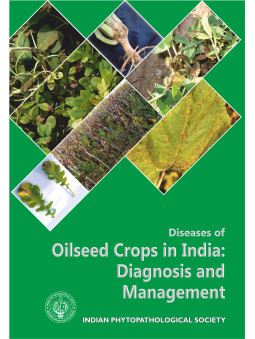Diseases of Oilseed Crops in India: Diagnosis and Management

| Editors: Pankaj Sharma, Ritu Mawar and Kuldeep Singh Jadon |
| Year: 2023 |
| Price : INR 1495.00 |
| ISBN: 978-93-94678-02-6 |
About the Book
India is one of the major oilseeds grower and importer of edible oils. India’s vegetable oil economy is world’s fourth largest after USA, China and Brazil. It has 20.8% of the total area under cultivation globally, accounting for 10% of global production. The country produces groundnut, soybean, sunflower, sesamum, niger seed, rapeseed-mustard and safflower oilseeds. Nearly 72% of the oilseeds area is restricted to rainfed farming done by small farmers which led to poor productivity. However, a breakthrough was realized in oilseed production through introducing latest crop production technologies. Consequently, the oilseed production grew to 365.65 tonnes in 2020-21 from 108.3 lakh tonnes in 1985-86. The production of oilseeds in India has been growing for the last five years. In 2020-21, the production of the country was 365.65 lakh tonne which was a 10% increase from that of the previous year. From the years 2015-16 to 2020-21, the compound annual growth rate (CAGR) of production was 7.7%. Oilseeds and their products mainly oils and meal are the second most valuable commodity in the world trade. The trade in these commodities has expended rapidly to meet the requirements of growing population. Technologies are being developed to eliminate to make use of oilseed meals from sesame, rapeseed-mustard, linseed, groundnut, sunflower, caster, safflower in various food products. Oilseeds are viewed not only as a source of oil, but also potential source of dietary proteins. Efforts have therefore, been made to increase the production of oilseeds and to improve the supply of oil. Lack of appropriate technologies, cultivation under input-starved conditions, combating the biotic and abiotic stresses are some of the major causes for poor productivity of oilseeds. under biotic stresses, some of the diseases are endemic and causes substantial damage every year. Under favorable environments some of the diseases may become epidemic and cause considerable damage to the crop. We appreciate the efforts of the Indian Phytopathological Society, New Delhi and sincerely thanks to all the contributors who shared their valuable findings in this important compilation which is very useful for researchers, extension personnel, students and other oilseed stakeholders.
Contents
Introduction 1
1. Current status of rapeseed-mustard diseases and
their management strategies - Pankaj Sharma (3-15)
2. Compendium of soybean diseases scenario in
India and various aspects of management - S. Jahagirdar and Gurudatt M. Hegde (16-28)
3. Diseases of groundnut: diagnosis, etiology,
epidemiology and management - Kuldeep Singh Jadon, S. K. Singh and PP
Thirumalaisamy (29-69)
4. Major diseases of sesame: extent and management
- Ritu Mawar and Kartar Singh (70-94)
5. Important diseases of linseed and their
effective management - K. Ajith Kumar, B. Lingaraju, A.S. Savitha and R.D.
Prasad (95-104)
6. Present scenario of castor diseases and
integrated management - M. Santha Lakshmi, R.D. Prasad, G.P. Gangwar, Umesh M.
Vyas, V. Divya Rani, N. Indra and Rekha Kumawat (105-126)
7. Disease of safflower and integrated management -
D.M. Murumkar, T. Rajeshwar Reddy, S.V. Pawar, Prabhavati Eshwar and R.D.
Prasad (127-134)
8. Important diseases of sunflower caused by plant pathogenic fungi and viruses - L. Rajendran, R.D. Prasad, K. Venkataramanamma, C. P. Manjula and T. Poornima (135-148)
9. Integrated disease management in niger - M. Santha Lakshmi Prasad and R.D. Prasad (149-153)